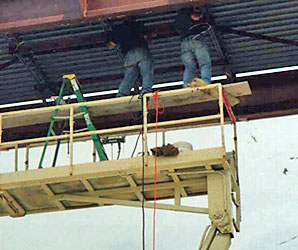Personal Fall Protection
Falls are the second leading cause of occupational fatalities and disabling injuries in the United States. Each year, over 500 workers die in fall-related accidents and over 300,000 workers suffer a disabling injury.

Whenever feasible, employers should always set up temporary floors, guardrails, toeboards, or other physical barriers to falls. When not feasible, personal fall protection or safety nets must be used. No work should proceed unless the necessary fall protection is in place. The use of fall protection can prevent serious injury and save your life.
Fall protection equipment is broadly divided into two categories:
-
One is fall prevention equipment. Guardrails and coverings at floor openings and safety-interlock gates on elevated platforms are designed to prevent falls. A body harness worn by the worker can also be used to tether him/her to an area away from the fall hazard.
- Fall arrest equipment is designed to save the worker if he/she falls. He/she may wear Personal rotective Equipment consisting of a body harness and lanyard attached to a lifeline or an anchor point.
Fall Restraint:
Fall Restraint includes such items as a guardrail or parapet wall. It can also consist of a personal fall restraint system which keeps you from reaching an unprotected “fall” point. Guardrails are considered to be a Fall Restraint type of fall protection
Fall Arrest:
One type of appropriate fall protection equipment is the personal fall arrest system. The entire personal fall arrest system must be capable of withstanding the tremendous impact forces involved in a fall.
A personal fall arrest system includes a full body harness, a shock absorbing lanyard or a rope grab and vertical lifeline, and a sound anchorage able to support a load of 5000 pounds.
Working safely may get old…but so do those who practice it!!
Download flyer: STOTW_27_Personal Fall Protection.pdf (108.96 kb)

